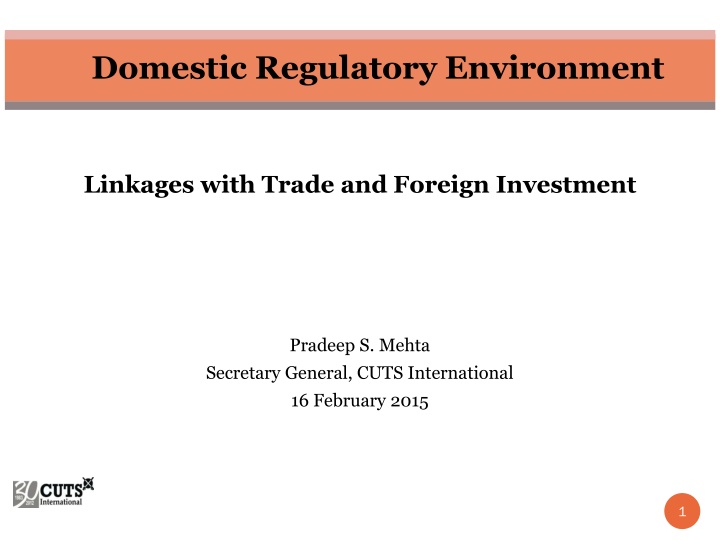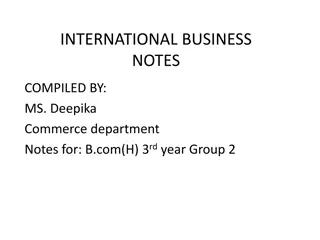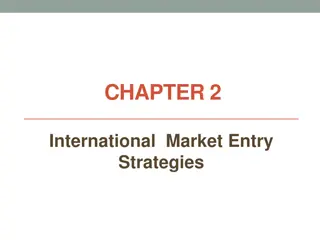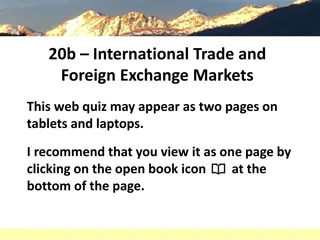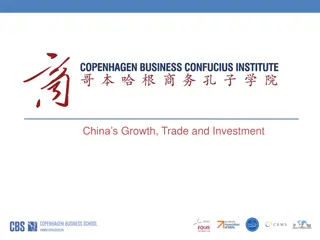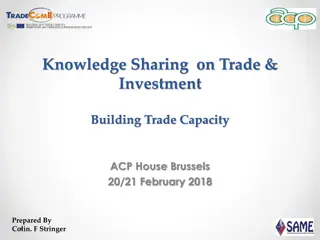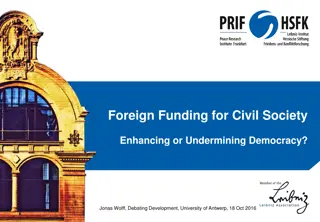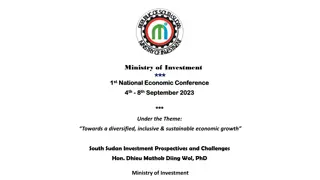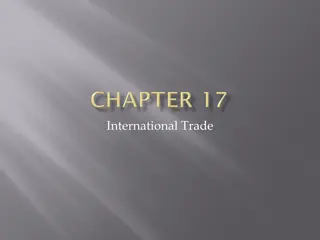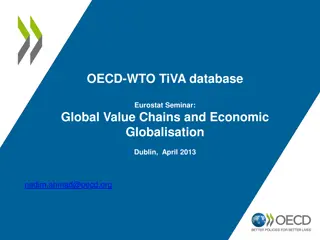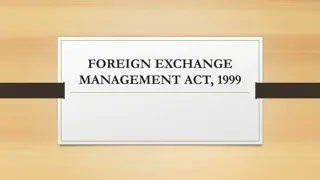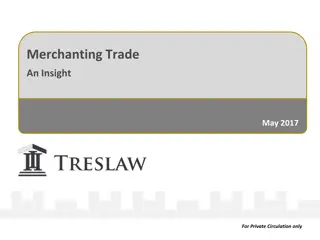Domestic Regulatory Environment Linkages with Trade and Foreign Investment
This content discusses recent developments, components, effects of sub-optimal DRE, policy drivers, and more in the context of domestic regulatory environments and their impact on trade and foreign investment. Topics include policy uncertainty, growth in world trade, domestic and international policies, bilateral agreements, and dispute resolution mechanisms.
Download Presentation

Please find below an Image/Link to download the presentation.
The content on the website is provided AS IS for your information and personal use only. It may not be sold, licensed, or shared on other websites without obtaining consent from the author.If you encounter any issues during the download, it is possible that the publisher has removed the file from their server.
You are allowed to download the files provided on this website for personal or commercial use, subject to the condition that they are used lawfully. All files are the property of their respective owners.
The content on the website is provided AS IS for your information and personal use only. It may not be sold, licensed, or shared on other websites without obtaining consent from the author.
E N D
Presentation Transcript
Domestic Regulatory Environment Linkages with Trade and Foreign Investment Pradeep S. Mehta Secretary General, CUTS International 16 February 2015 1
Scope Not about processes involved in domestic regulatory framework (DRE) or measures needed to improve it Outline Recent developments Components of DRE Effect of sub-optimal DRE Policy drivers of DRE Domestic experience International experience 2
Recent developments Finalisation of Administrative Arrangement to implement India-US 123 Agreement Implication: Starting of commercial negotiations for setting up nuclear reactors Programme for Enhancement of Cooperation in Oil & Gas between India and Russia Implication: Joint exploration and production of hydrocarbons Sub-regional motor vehicle agreement in Bangladesh, Bhutan, India and Nepal Implication: Facilitate cargo and passenger movement amongst these countries Agreement on Trade Facilitation (WTO) Implication: Expediting the movement of goods and reduction in trade cost SAARC Framework Agreement for Energy Cooperation (Electricity) Implication: Enabling cross-border trade of electricity 3
Components of DRE Domestic and international policies, legislations, guidelines, and mechanisms Domestic regulatory environment National and sub-state organisations, judicial and quasi- judicial authorities and processes thereof 4
Effect of sub-optimal DRE The world FDI inflows have fallen from the high of USD 2.00 trillion in 2007 to USD 1.45 trillion in 2013 (UNCTAD). Growth in world merchandise trade remained subdued in 2013 and early 2014, at around 2.2 percent (WTO). Reasons include: Economic fragility and policy uncertainty (World Investment Reports, 2013 and 2014) Regulatory and policy uncertainty and deteriorating business confidence, specifically in case of India (Anand and Tulin, 2014) Increase in policy uncertainty, specifically in case of United States (Baker, Bloom, Davies, 2013) 5
Policy drivers of DRE Domestic policies, legislations and practices: Investment regime Taxation policy Competition policy Intellectual property rights regime Grievance redressal mechanism Bilateral and international commitments (influence domestic policies): WTO commitments Bilateral and multilateral agreements Dispute resolution mechanism Demand driven 6
Domestic policies/ legislations: Illustrations FDI policy: FDI up to 49 percent under government route allowed in defence sector, beyond which approval of Cabinet Committee on Security required for FDI in state-of-art technology (PN 7 of 2014) FDI up to 100 percent under automatic route allowed in railway infrastructure (non-sensitive areas, wherein approval of CCS required) (PN 8 of 2014) FDI up to 49 percent in insurance sector (Insurance Ordinance, 2014) Taxation policy: Introduction of Goods and Service Tax Draft National Competition Policy: Adoption of pro-competition principles IPR regime Grievance redressal: Quantity and quality concerns 7
International commitments: Illustrations International commitments influence development of domestic policies WTO: Principles of non discrimination, reciprocity, binding and enforceable commitments, transparency Agreement on Application of Sanitary and Phytosanitary measures: Food safety and standardisation issues Trade Facilitation Agreement Bilateral/ Multilateral agreements: Double tax avoidance agreements Bilateral and regional investment agreements. E.g. proposed India-US BIT and Social Security Agreement, TTIP, TPP Relook at BITs 8
Policies are not enough Enabling domestic and international policies, while necessary, are not sufficient, to attract investment and enhance trade Appropriate organisations are required to be created to house the policies and regulations and ensure their implementation Appropriate processes need to be put in place to ensure sustainability and adaptability of policies and regulations. Weak processes result in institutional weaknesses Organisations and process comprise institutional drivers of DRE. Stakeholder participation is inherent component of good institutions 9
Achieving right balance is the key - Independence - Transparency - Predictability - Cost-effectiveness - Regulatory capture -Accountability - Commercial sensitivity -Adaptability - Promptness - Stakeholder participation 10
Domestic experience of DRE Policy DRE Reason Taxation Retrospective taxation (Vodafone) and protracted litigation (Nokia) Lack of clarity in regulatory objectives and limited accountability FDI in multi- brand retail Absence of investment Power to states to decide respective policies resulting in uncertainty Railways Sub-optimal and discriminatory practices performance, monopoly No institutional independence and lack of adequate processes Electricity Monopolistic structure of state utilities and dysfunctional Lack of effective independence and competition Agriculture Distortions inadequate regulation of intermediaries in marketing and Absence of appropriate tools and inadequacy of regulatory processes 11
Domestic experience of DRE Policy DRE Reason Education Multiple regulators and overregulation No clarity in institutional objectives Healthcare Regulatory entry barriers and collusive practices Sub-optimal inefficient grievance redressal policy making and Road transport Discretionary and preferential treatment licensing, cartelisation Abuse of discretion and absence of adequate processes Finance Regulatory arbitrage and preferential treatment Lack of clarity in institutional thinking Telecom Increase in teledensity, improvement in availability and quality Institutional adequate processes independence and Only 10% of investments actually materialise in India 12
International experience of DRE California: Think Long Initiative effective public participation in governance Mexico: Whole of government approach competition and regulatory reforms, taking into account concerns of opposition parties. ProMexico promotion of trade and investment Detroit: Land use reforms, disinvestment and privatisation, building institutions and processes Australia: National Competition Policy, Regulatory Impact Assessment and systemic review EU: Competition reforms in railways and transportation sector UK: Cutting red tape and One-in, Two-out initiatives 13
Thank You www.cuts-international.org cuts@cuts.org 14
